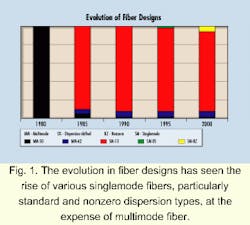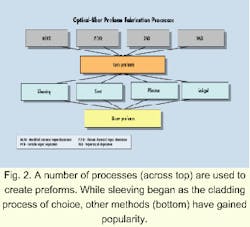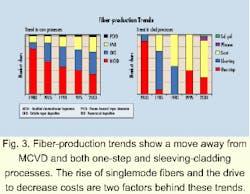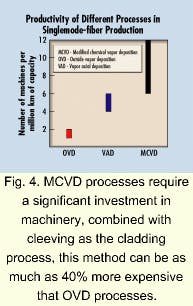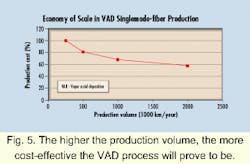Trends in optical-fiber technologies
Over the last two decades, optical fibers have revolutionized the communications industry. Meanwhile, continuous innovations in optical components have made it possible to design and implement higher and higher bit-rate systems-and the trend continues unimpeded. Consequently, fiber designs continue to evolve in almost every segment of the network hierarchy. Multimode fibers were dominant in the 1970s, and singlemode fibers operating at 1.3 microns became the dominant product in the 1980s. The emergence of the nonzero dispersion-shifted fiber (NZ-DSF) for very high-bandwidth dense wavelength-division multiplexing (DWDM) systems in the 1990s make us wonder what the dominant fiber will be in the next decade.
Meanwhile, the manufacturing processes for optical fibers have continued to become more productive, permitting price reductions to levels few had imagined possible. But in the two decades since its inception, the fiber industry has not stabilized in terms of manufacturing technologies. Four distinctly different processes coexist in the market: outside vapor deposition (OVD), vapor axial deposition (VAD), modified chemical vapor deposition (MCVD), and plasma chemical vapor deposition (PCVD). Production facilities producing less than 100,000 km per year coexist with those producing several million kilometers per year.
The industry is dominated by fewer than 10 production groups-three or four in each of the North American, European, and Asian continents-that participated in the intensely competitive research and development that went on in the 1970s and 1980s. Collectively, they produce more than 90% of the world's fiber output. But other companies have bought commercially available equipment and technology and in a relatively short time established themselves as viable fiber suppliers in the international market.
Are the differences between the processes so small that they can be considered more or less the same? Does the choice of product affect the choice of production process? Will production facilities best-suited for standard singlemode fiber work as effectively for the eventually standardized NZ-DSF? Will the small companies be able to compete with the large fiber-producing conglomerates in their domestic markets, and if so, under what circumstances?Figure 1 shows a qualitative chart for the evolution of optical-fiber designs represented in kilometers of output. A review of the market in terms of dollars will show standard singlemode fiber to be smaller in market share; multimode fibers and NZ-DSFs sell for about twice and three times that of singlemode fibers, respectively.
The optical-communications industry started in the 1970s with the use of graded-index multimode fibers. The relatively large core diameter of 50 microns was probably the most important driver of this design. As the industry gained experience in installation and operation and as singlemode fiber and components for singlemode communications systems evolved, the lower attenuation and higher-bandwidth capability of singlemode-fiber systems far outstripped the benefits of multimode-fiber systems. By the middle of 1980s, singlemode fibers operating at 1.3 microns became the dominant fiber used in long-distance networks.
Short-distance applications for campus networks and local area networks (LANs) continued to use multimode fibers. However, the design of choice became a fiber with a higher numerical aperture in the core-62.5 microns. Short-distance networks in Europe became a mix of 50- and 62.5-micron fibers; this market segment has not developed very significantly in Japan. How short-distance networks evolve for future fiber-to-the-desktop and fiber-to-the-home applications will affect this market significantly. In all likelihood, 62.5-micron graded-index multimode fiber will not continue to dominate the market because of its bandwidth limitations and comparatively high cost.
In long-haul networks, dispersion-shifted fibers were introduced for operation at 1.55 microns. But problems with four-wave mixing and other nonlinear effects limited use of the bandwidth potential of these fibers. Elimination of the four-wave mixing problem by the development of NZ-DSF, coupled with the advent of broadband amplifiers and associated components, has permitted introduction of very high-bandwidth DWDM systems. As communications carriers accept this new technology, the market share of NZ-DSF will increase at the expense of standard singlemode fibers. Proponents of NZ-DSFs forecast penetration of as much as 20% of the fiber market. On the other hand, those who believe the low-cost standard singlemode fiber, in conjunction with components optimized for use in high-bandwidth DWDM systems, will be the more cost-effective solution do not think penetration of NZ-DSF will exceed 5% of the market. (For more on this controversy, see "Optical-fiber selection considerations with evolving system technologies," page 60.)The changes in process technology have been more dynamic than in product designs. The fiber-production processes were introduced here in the same way they have been traditionally represented in the industry. However, simply describing a process as MCVD or VAD does not fully describe the manufacturing processes. Commercial processes to produce preforms by vapor deposition today are all two-step processes and better represented as shown in Figure 2, in which the old terminology would refer only to the first process step of preform fabrication. The core and part of the cladding required to ensure the optical quality of the resultant fibers are produced in this process step. Depending on the size of the core preform, the preform may or may not be elongated into a number of rods, upon which additional cladding is added to complete the preform from which fiber will be drawn.
"Sleeving" involves the collapse of a silica tube on the core preform and is the most popular overcladding process for MCVD and PCVD core preforms. But sleeving tubes are very expensive. Alcatel and Lucent, both predominantly MCVD fiber producers, have recently commercialized plasma spray and sol-gel overcladding processes as alternatives to sleeving. All the VAD and OVD fiber producers, with the exception of one VAD fiber producer, use soot overcladding.The evolution of preform production processes is qualitatively shown in Figure 3. Since MCVD was the first process to mature, the initial multimode fibers were mostly MCVD fibers, with VAD and OVD processes producing small quantities of fibers. The switch to singlemode fibers coincided with the maturation of the OVD and VAD processes. In the 1980s, Corning and Furukawa stopped using the MCVD process. In the 1990s, the number of VAD fiber producers increased dramatically with Shin-Etsu, Hitachi, Mitsubishi, and Showa in Japan obtaining licenses from Nippon Telegraph & Telephone. In Europe, with a license from Sumitomo, Pirel* developed and commercialized the VAD process. Lucent acquired a license from Sumitomo and introduced VAD into its Atlanta factory after Lucent had an opportunity to observe VAD in production for several years at its joint venture with Sumitomo in the United States. Spectran acquired a modified version of the VAD process when it purchased the assets of Ensign-Bickford Optics. Consequently, the use of the MCVD process continued its slide throughout the 1990s.
The development and acceptance of the NZ-DSF in the market is expected to create a discontinuity in the trend of core processes shown in Figure 3. Although NZ-DSF designs continue to evolve and at this time there are no standards, a consensus seems to be emerging that the eventual standardized design will have segments of the core that have a refractive index lower than that of fused silica, which will require fluorine doping. Alternating layers of raised-index layers by germania doping and lowered index layers by fluorine doping, although possible by all the processes, is easier done in MCVD and PCVD processes. Therefore, increases in the production volumes of NZ-DSF are likely to increase the use of the MCVD and PCVD processes.
Corning, which uses the OVD process, and large VAD manufacturers such as Sumitomo, Fujikura, Furukawa, and Shin-Etsu may have to consider reintroduction of MCVD or PCVD in their plants or choose not to produce NZ-DSF preforms. At the same time, sharp reductions in singlemode fiber prices are forcing MCVD and PCVD fiber producers to consider alternative technologies for their core process.
The conversion of preform fabrication to a two-step process by sleeving a core preform started with commercialization of the VAD process. But in the early 1980s, Corning commercialized an alternative to sleeving: soot overcladding. The market share of sleeving declined through the 1980s as all the VAD fiber producers switched to soot overcladding. In the 1990s, the introduction of plasma spray by Alcatel and sol-gel by Lucent is expected to continue to reduce the market share of sleeving tubes.
One reason for this erosion of market share is tube cost. Cost analyses indicate that sleeving-tube prices need to drop to about $100 per kilogram for it to be competitive with the other clad processes. At this time, it is considered unlikely that tube prices will drop to that level. Another significant reason is the degree of difficulty in producing tubes for larger preforms. In fact, several fiber manufacturers who currently sleeve have claimed that they could produce larger preforms if sleeving tubes were available in larger sizes. Larger preform size will be increasingly critical for survival as fiber price continues to drop. Thus, like Alcatel and Lucent in the 1990s, other singlemode-fiber manufacturers will forgo sleeving and opt for a cost-effective clad technology that permits high yield production of large preforms. Most of them will probably choose soot overcladding for which equipment and technology have become available.The dominant fiber in the near future will continue to be standard singlemode. The results of recent analysis of the different processes used to produce singlemode fibers are shown in Figure 4, which compares the number of machines required in each process to produce 1 million km of fiber. The productivity of the different core processes and their cost-effectiveness for production of different fibers vary significantly. The OVD/oscillating-soot process is considered the least-expensive process, with estimated factory production cost in the range of $15 per kilometer. The production cost of VAD/traversing-soot and MCVD/sleeving singlemode fibers range from 25% to 40% higher than that of the OVD/oscillating-soot process.
Most of the smaller plants are also older plants that use significantly dated technology. These plants will survive only in protected and captive markets. Assuming the same level of technology, the production cost of singlemode VAD fibers produced in factories of different capacities is shown in Figure 5, which indicates a significant advantage in high-volume production. On the other hand, the model only simulates single-technology factories. What happens to production cost if these plants have to be multitechnology plants producing multiple products? Most will agree that the odds still favor the large established manufacturers. As prices drop and the processing rates increase, the minimum size of an economically viable production facility keeps increasing.The high-capital intensity and lack of availability of state-of-the-art technology have created a daunting entry barrier to the fiber-production business. Nevertheless, there is a large number of companies who feel up to the challenge. The technology renewal being forced upon existing manufacturers by the sharp price reductions seen in 1997 and 1998, in addition to the introduction of NZ-DSF and expiration of the basic process patents, may create enough of a discontinuity to offer a window of opportunity for new entrants.
The optical-fiber industry appears mature and stable in comparison with the dynamics of the optical-component market. The reality is quite different-half the fiber manufacturers are scrambling to survive because of the rapid drop in fiber prices over the last few years. At the same time, single-technology companies are having to scramble to develop new technologies to increase their ability to serve the market.
There will be many fiber-production facilities going out of business in the next decade, but determination of the most efficient structure of this industry will evolve over a longer period. In the meantime, the dynamism of the communications market will continue to drive the industry.
Arnab Sarkar is the founder of Bular LLC, a startup optical-fiber company. He can be reached at [email protected].
